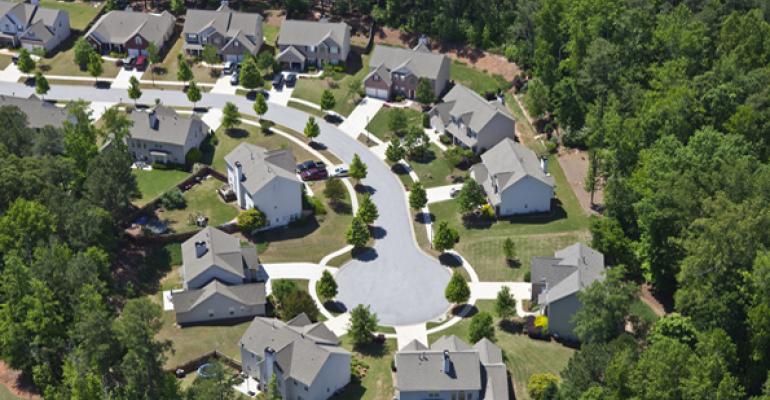Investors are buying fewer single-family homes, according to data firm RealtyTrac’s 2014 U.S. Institutional Investor & Cash Sales Report. However, many investors continue to buy and seem committed to the business of renting out their portfolios of single-family homes.
“The single-family rental market has been around for a long time. It’s gotten a lot of press recently, but it’s always been there,” says Mark Palim, Fannie Mae’s vice president for applied economics and housing research. “It’s a key piece of the housing market.”
Single-family investors played a high-profile role in the housing recovery, as private equity firms like Blackstone bought hundreds of thousands of foreclosed homes and turned them into rental properties. Home prices rose dramatically in many markets. Today investors are buying fewer single-family homes as their business enters a new phase—based on a strong overall economy instead of a tidal wave of foreclosed homes available at steep discounts.
“We are in a tricky transition period,” says Daren Blomquist, executive vice president for data solutions for RealtyTrac. “The main focus now is on rental income or cash flow.”
Fewer investor purchases
Institutional investors bought just 105,278 single-family homes in 2014—that’s 4.2 percent of all sales. It’s also a steep drop from the 153,450 single-family homes these investors bought in 2013. Over the past four years, institutional investors have purchased a total of 528,369 single-family homes nationwide, or an average of about 132,000 per year, according to RealtyTrac, which counts as an “institutional investor” buyers who purchase 10 or more homes a year. Over those four years, these institutional investors bought 5.61 percent of all single-family homes.
“We are seeing the investor surge wind down,” says Blomquist. “They are going to continue buying though they are less aggressive.”
Meanwhile, home prices are still rising, though much less quickly. Prices are likely to rise 4.6 percent in 2015 and 4.0 percent in 2016 on the Federal Housing Finance Agency Index, according to the latest forecast from mortgage giant Fannie Mae. That’s solid appreciation, well above the rate of inflation. But that appreciation would still be disappointing compared to 7.7 percent rate in 2013. “Home price appreciation cannot become too detached from what is happening with household incomes,” says Fannie Mae’s Palim. “People need incomes to support those mortgages.”
Investors are also providing less support to home prices. “Many investors have started getting priced out of many markets,” says Blomquist. Average capitalization rate for single-family rentals fell to 9 percent in 2014. That’s down from 10 percent, according to RealtyTrac. Cap rates represent the income produced for a property as a percentage of the sale price. RealtyTrac bases its calculations on the median home prices and the local Fair Market Rents computed by officials at the U.S. Dept. of Housing and Urban Development. Blomquist expects cap rates for single-family rental homes to stabilize in the coming years between 9 percent and 6 percent.
Policy makers have recently taken steps to make it easier for potential homebuyers to get a mortgage, including lower premiums for Federal Housing Administration insurance programs. A strong job market may also help strengthen the housing markets—including demand for both rental housing and for-sale homes. “We are at a key transition point,” says Fannie Mae’s Palim. “We should see a pickup in home sales.” More than 5 million existing homes should sell in 2015, according to Fannie Mae’s latest forecast.
Investors hold their properties
Even though appreciation is slowing, the largest investors remain committed to holding their properties. “We are not seeing a lot of sales,” says Blomquist.
However, the business of renting single-family homes is consolidating as the largest companies buy the portfolios of mid-sized companies. The American Home recently announced the sale of a portfolio of 2,460 single-family rental homes to Silver Bay Realty Trust for $263 million. American Homes 4 Rent also bought Beazer Pre-Owned Rental Homes Inc., in a deal announced last summer.
Leading investor Blackstone, for example, shows no sign of selling. “They are very committed to holding on for at least the next few years,” says Blomquist of Blackstone’s huge portfolio of 45,000 single-family properties for rent. In fact, Blackstone has sold bonds to Wall Street based on the rental income from its properties. Rental housing operators like American Homes 4 Rent and Starwood Waypoint Residential Trust have also securitized the cash flow from their properties. These deal would make it awkward, to say to least, for the firms to sell their single-family portfolios. “They are at least in these for the next few years,” says Blomquist.
Investors like Blackstone have also created a new way for other investors to put money into single-family rental housing: as a lender. The private equity firm has created B2R Finance. B2R stands for "buy to rent," and provides financing tailors to investors who buy small properties to rent.

